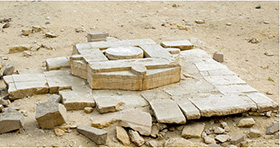Old Kingdom Monuments
- Neolithic Period: 4500-3000 BCE
- Early Dynastic: 3000-2650 BCE
- Old Kingdom: 2650-2150 BCE
- 1st Intermediate Period: 2150-2040 BCE
- Middle Kingdom: 2040-1640 BCE
- 2nd Intermediate Period: 1640-1550 BCE
- New Kingdom: 1550-1070 BCE
- 3rd Intermediate Period: 1070-712 BCE
- Saite and Late Periods: 712-332 BCE
- Greco-Roman Period: 332 BCE-642 CE
- Coptic Period: 395-642 CE
- Islamic Period and Modern Times: 642 CE-Today
- Neolithic Period: 4500-3000 BCE
- Early Dynastic: 3000-2650 BCE
- Old Kingdom: 2650-2150 BCE
- 1st Intermediate Period: 2150-2040 BCE
- Middle Kingdom: 2040-1640 BCE
- 2nd Intermediate Period: 1640-1550 BCE
- New Kingdom: 1550-1070 BCE
- 3rd Intermediate Period: 1070-712 BCE
- Saite and Late Periods: 712-332 BCE
- Greco-Roman Period: 332 BCE-642 CE
- Coptic Period: 395-642 CE
- Islamic Period and Modern Times: 642 CE-Today
Abu Ghurab
Built ca. 2430 BCE
Six miles southwest of Cairo, just north of Abusir, is one of only two Old Kingdom sun temples known to have survived, although it is believed that many others existed and were destroyed, fell into ruin, or haven’t been found yet. The building of sun temples was the result of a gradual rise in importance of the sun-god. During the Old Kingdom, Ra became like a state deity. The ruins at Abu Ghurab were once the Sun Temple of Pharaoh Nyuserra (reign ca. 2445-2421 BCE).
The upper temple included a 60-foot high (20 meters) pedestal supporting a 118-foot (36 meters) obelisk, a symbol of the sun-god. An altar was built directly in front of the obelisk (to the east) in the court, open to the sun. This altar was made of five huge white alabaster blocks, which were arranged to form a symbol meaning “Ra is satisfied.”
Along the east wall of the courtyard nine circular alabaster basins survive. Some researchers suggest that these may have been used to levitate objects through the vibrational manipulation of water.
The walls at Abu Ghurab included reliefs that emphasized the sun-god’s role as the ultimate giver of life and the moving force in nature, and established the king’s place in the eternal cycle of events by showing his celebrations of the sed-festivals. Two sections of low reliefs, known as the “Chamber of the Seasons,” described the changing seasons of inundation and harvest. They were removed and are now on display in the Egyptian Museum in Berlin. There was most likely a third section describing the “season of emergence” (emergence of the fields from the flood or of the crops from the ground).
Nearby was a large mud-brick replica of a barque of the sun-god. The sun temples were personal monuments to each king’s continued relationship with the sun-god in the Afterlife.
Ramses II had this temple restored during the New Kingdom. His son, Khaemwese, the High Priest of the Temple of Ptah in Memphis, was very interested in rebuilding traditional building sites in northern Egypt.

http://www.egyptian-museum-berlin.com/c41.php#7
http://www.human-resonance.org/levitation_basins.html
Shaw, Ian. The Oxford History of Ancient Egypt. New York: Oxford University Press, 2000.
http://www.touregypt.net/featurestories/niuserresuntemple.htm

